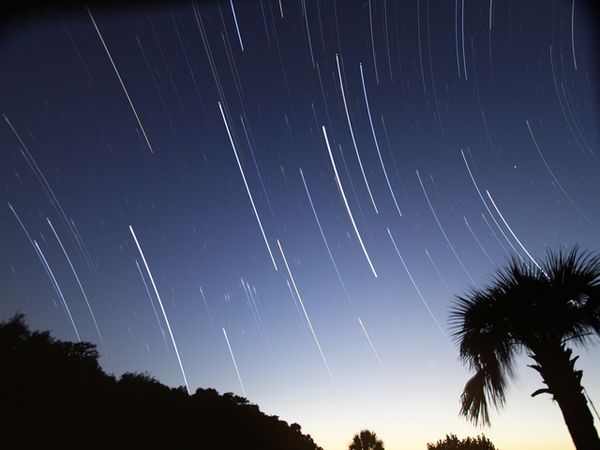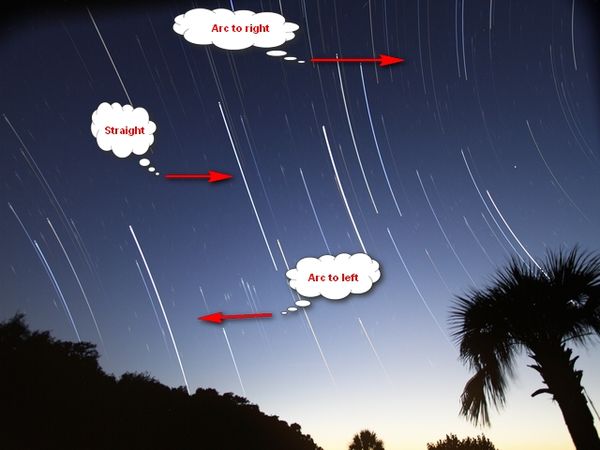Star Trails
Apr 25, 2014 15:44:15 #
I am new to this, and bought a cheap e-bay battery grip intervalometer for my camera. The first night out I forgot about the on/off switch, and thought the cheap knock off does not work, worked at home. The second night I thought I better shoot in my backyard and got everything to work.
So last night I went to Myakka SP and shot to the SW so I could get a palm tree in the foreground, to make the shot a little more interesting, and the horizon with the sunset.
So the question I have for everyone is why I have three sets of star trails? One circles to the right, the middle is mostly straight and the left side circles in the opposite direction. I am attaching two images one as shot and stacked, and one with text remarks by me.
I used Startrails 2.3 to stack the images. I shot 212, 30 second exposures, with a 5 sec. delay between exposures. I set my camera to ISO 250, and lens set to infinity and at 10 mm (16mm equiv.). Canon 7D and EF-S 10-22mm lens.
Any help is greatly appreciated. Thank You, Gary
So last night I went to Myakka SP and shot to the SW so I could get a palm tree in the foreground, to make the shot a little more interesting, and the horizon with the sunset.
So the question I have for everyone is why I have three sets of star trails? One circles to the right, the middle is mostly straight and the left side circles in the opposite direction. I am attaching two images one as shot and stacked, and one with text remarks by me.
I used Startrails 2.3 to stack the images. I shot 212, 30 second exposures, with a 5 sec. delay between exposures. I set my camera to ISO 250, and lens set to infinity and at 10 mm (16mm equiv.). Canon 7D and EF-S 10-22mm lens.
Any help is greatly appreciated. Thank You, Gary
Apr 25, 2014 15:45:48 #
Your camera with wide-angle lens is aimed West or East. If you aim North, you will see star Polaris, around which the northern hemisphere pivots, causing arced star trails centered on Polaris. Below the Equator, aiming your camera due South will capture similar results circling around the southern pivot point.
Lincoln Harrison is my favorite star trailer. Here is his Flickr page: http://www.flickr.com/photos/hakka69 Scroll down to see scores of star trail images.
Lincoln Harrison is my favorite star trailer. Here is his Flickr page: http://www.flickr.com/photos/hakka69 Scroll down to see scores of star trail images.
Apr 25, 2014 16:02:15 #
Thank you, I was pointed SW. So why two arcs? I shot this in Sarasota, FL.Gary
Apr 25, 2014 16:06:45 #
gwong1 wrote:
Stars 'north' of the equator leave trails arcing around Polaris; stars directly above the equator leave straight star trails; stars 'south' of equator leave trails arcing around southern hemisphere pivot point.I was pointed SW. So why two arcs? I shot this in Sarasota, FL.Gary
Apr 25, 2014 16:34:59 #
Thanks again, I did not think I could see stars south of the equator. Gary
Nikonian72 wrote:
Stars 'north' of the equator leave trails arcing around Polaris; stars directly above the equator leave straight star trails; stars 'south' of equator leave trails arcing around southern hemisphere pivot point.
Apr 25, 2014 16:56:00 #
Apr 25, 2014 19:21:21 #
mechengvic wrote:
Most star-trail photographers use wide-angler lenses. Look here: http://www.flickr.com/photos/hakka69/sets/72157625419059738are you sure it's not due to the curvature of your wide angle lens?
Apr 26, 2014 02:29:18 #
Take a look at this Wikipedia page and watch the animated .gif on the right. http://en.wikipedia.org/wiki/Declination
Then you can more readily visualize what you are seeing and why you can see stars south of the equator. You are on a sphere and when you look toward the horizon that is a tangent. You can't see southern sky that is below your horizon.
Take a globe and ruler. Put the middle of the ruler on Sarasota parallel to the lines of longitude N-S. The ruler is now part of a cone as the earth rotates. Everything outside the cone you can see. Under the cone you can't see. Put the ruler on the equator and now it's a cylinder.
If I took that exact same picture where I'm located the angle of the straight trails would be greater because I'm at 47 deg N and you are at 27 deg N. My picture would show more trails to the right. My "cone" is fatter than yours. At the North Pole there would be no cone. If you took this picture at the Pole, the straight trails would be horizontal. At the equator they would be vertical.
I hope I'm not patronizing...
Then you can more readily visualize what you are seeing and why you can see stars south of the equator. You are on a sphere and when you look toward the horizon that is a tangent. You can't see southern sky that is below your horizon.
Take a globe and ruler. Put the middle of the ruler on Sarasota parallel to the lines of longitude N-S. The ruler is now part of a cone as the earth rotates. Everything outside the cone you can see. Under the cone you can't see. Put the ruler on the equator and now it's a cylinder.
If I took that exact same picture where I'm located the angle of the straight trails would be greater because I'm at 47 deg N and you are at 27 deg N. My picture would show more trails to the right. My "cone" is fatter than yours. At the North Pole there would be no cone. If you took this picture at the Pole, the straight trails would be horizontal. At the equator they would be vertical.
I hope I'm not patronizing...
Apr 26, 2014 06:44:45 #
Skylane, your clarification along with the other answers are a big help for me. I'd had the same question with some of my star trail shots and always thought it was the 'distortion' (for lack of a better word) of my wide angle lens...but then I'm so new at this too, so lots of learning.
Thanks to the OP for the question, and to the others for the answers!
Thanks to the OP for the question, and to the others for the answers!
Apr 26, 2014 08:13:16 #
Skylane5sp, Thank you for your explanation, which now makes sense to me. I also contacted Douglas Vincent, who is also an astro photographer, and got this reply, very similar to yours. Thanks again, Gary http://www.astronomynotes.com/nakedeye/s4.htm
http://www.douglasvincent.com/photography/star-trails/
http://www.douglasvincent.com/photography/star-trails/
skylane5sp wrote:
Take a look at this Wikipedia page and watch the a... (show quote)
Apr 26, 2014 08:15:04 #
Douglas, Thank you again. I also contacted Douglas Vincent, who is also an astro photographer, and got this reply, very similar to yours. Thanks again, Gary http://www.astronomynotes.com/nakedeye/s4.htm
http://www.douglasvincent.com/photography/star-trails/
http://www.douglasvincent.com/photography/star-trails/
Nikonian72 wrote:
Stars 'north' of the equator leave trails arcing around Polaris; stars directly above the equator leave straight star trails; stars 'south' of equator leave trails arcing around southern hemisphere pivot point.
If you want to reply, then register here. Registration is free and your account is created instantly, so you can post right away.






